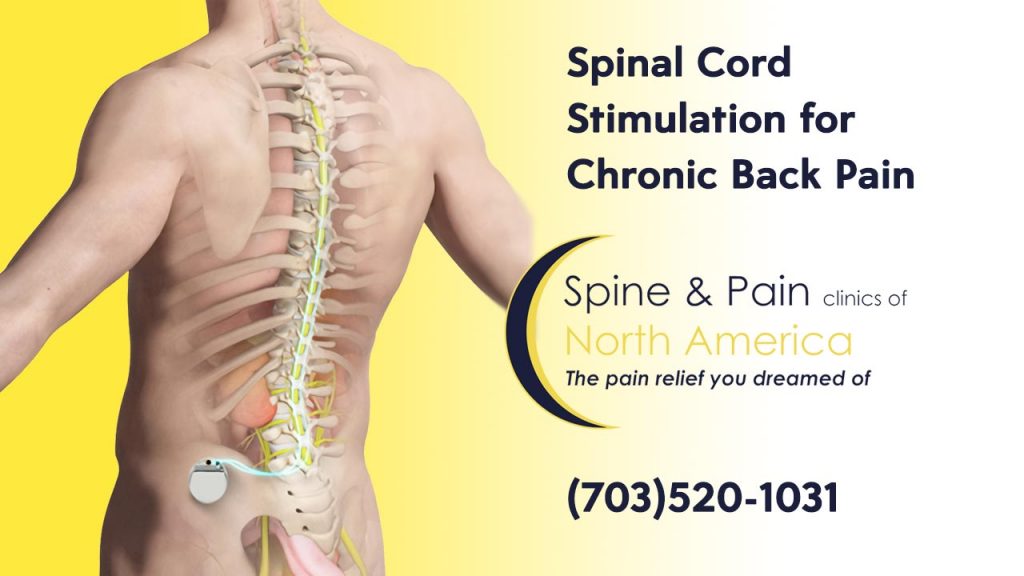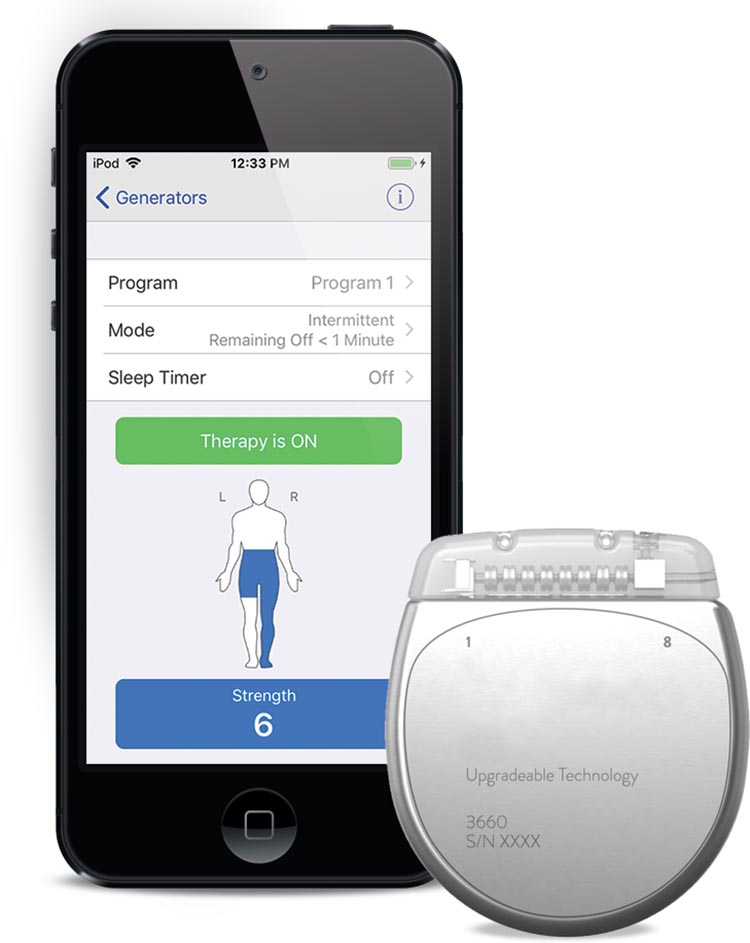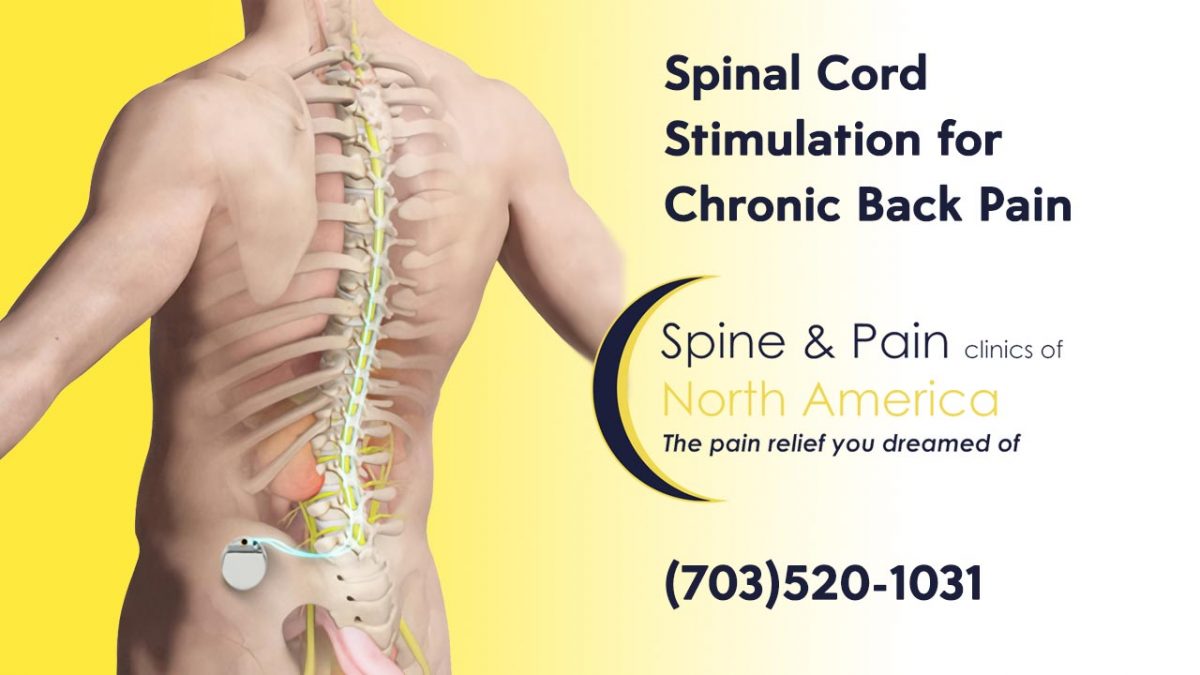Spinal Cord Stimulation
![]()
Call (703) 520-1031 or use the form below to send us your contacts.
What is spinal cord stimulation?

Spinal cord stimulation is an invasive procedure that is used for nerve pain due to post-laminectomy syndrome, radiculopathy, complex regional pain syndrome (CRPS), phantom limb pain, or neuropathy that is resistant to medications and minimally-invasive, injection-based treatments. Spinal cord stimulation therapy includes the implantation of a special device called a spinal cord stimulator.
What is a spinal cord stimulator?
A spinal cord stimulator is a small device with electrodes that are placed in epidural space under live x-ray guidance.
The epidural space is a space that is located in your spine within the spinal canal. This space sits between two planes of tissue: the sac of tissue that houses your spinal cord (dural sac) and the vertebral bones. The epidural space contains fat tissue with blood vessels and nerve roots. The electrode sends stimuli to your spinal cord that compete with the entry of pain signals. Instead of pain, you may feel a mild tingling sensation in the area where you usually feel pain.
The stimulator has a rechargeable battery. The newest technology being tested is wireless. A micro-transmitter, electrodes, and leads are implanted into the spinal space. All of the items are implanted with a hollow needle. A wearable antenna sends the signals wirelessly to the implanted system.
Every system has a remote control that enables turning the stimulator or generator on and off and changing the setting for the electrical pulses.

What is the purpose of spinal cord stimulation?
The spinal stimulator implantation is a therapy used to interfere with pain signals being sent from nerves to the brain. It is used for people experiencing chronic pain in the back, arm, or leg. The electrical pulses modify pain signals and mask them from reaching the brain.
Spinal cord stimulator therapy does not eliminate or cure what is causing the pain. It is simply designed to change the way the brain perceives pain. A spinal stimulator device may use a low-frequency current which is designed to change the feeling a patient experiences. It replaces a sensation of pain with more bearable paresthesia, a mild tingling feeling.
The spinal stimulator device that uses high-frequency current sends burst pulses. There is no tingling pain, meaning it is paresthesia-free.
Who is a candidate for spinal cord stimulation?
Spinal cord stimulation is used in certain situations, including but not limited to the following.
- Other pain therapies have failed to reduce chronic back pain or chronic neck pain
- A repair of an injury is not possible
- The cause of chronic pain is not treatable
- Heart pain has proven to be untreatable via other means
- The patient developed failed back surgery syndrome in which neck or back surgeries did not alleviate low back, arm, or leg pain
- Peripheral neuropathy exists which is persistent burning pain in the legs due to nerves dying in another area of the body
- Arachnoiditis is present in which inflammation and scarring of layers of the spinal nerves are causing pain
- The patient has reflex sympathetic dystrophy which is a progressive disease of the nervous system causing a feeling of persistent burning pain
- There is pain after an amputation
If a doctor recommends spinal cord stimulation therapy, there may be a trial period. During this trial, the transmitter is not implanted. It is worn externally and sends electrical pulses to the inserted wires and electrodes. The trial lasts from 5-7 days.
How is spinal cord stimulation performed?
There are two phases of spinal cord stimulator implantation.
1.Spinal Cord Stimulator Trial
First, a trial is aimed to test out the device before permanent implantation. The tip of the electrodes’ lead is placed in your epidural space. The tail is secured with tape and dressings to your back and connected to an external controller that can increase or decrease stimulation. You will be able to test this system for one week.
If the trial does not provide adequate pain relief, the lead of electrodes can be removed easily without damage to the spinal cord or nerves.
If the spinal cord stimulator provides sufficient reduction of your pain and improves your quality of life, you may be a candidate for permanent implantation.
2. Spinal Cord Stimulator Implantation
A spinal cord implantation procedure is performed under live X-ray guidance to ensure the accuracy and safety of this procedure. You will be asked to lie on your stomach then your back will be cleaned with an antiseptic, and a sterile drape will be placed. The physician will inject a local anesthetic to numb the skin. An epidural needle will then be guided to the epidural space.
The lead will be placed in the epidural space under X-ray guidance. During the procedure, you should be able to give feedback and confirm proper coverage of your painful areas. Prior to spinal cord stimulation implantation, an MRI is ordered to determine whether you have enough spinal space to have the lead placed.
What happens after spinal cord stimulation surgery?
Since the back stimulator only changes the brain’s perception of pain, there is no way to predict the results. A procedure that leads to at least 50 percent pain reduction is considered successful. The goal for most people is a 50-70 percent reduction in pain.
Some people experience as much as 80-85 percent pain reduction. One study (Kapural and Doust, et. al.) found that high-frequency back stimulation therapy resulted in significant pain relief in more than 80 percent of patients. Another study, titled Predictors of spinal cord stimulation success found that up to 30 percent of SCS patients do not experience long-term pain relief.
After the surgery, a patient is given a controller to manage the electrical pulses. The doctor may also ask the patient to track the stimulation settings, frequency of changes, and impact on pain.
How long is the recovery period?
Since an incision is made, there is some pain. It may take 2-3 weeks before able to resume light normal activities. The patient is instructed to limit some physical activities for approximately three months to avoid potential movement of the leads.
It could take 6-8 weeks for a full recovery.
What are the potential complications?
There are several potential complications that could develop from spinal cord stimulation for chronic pain.
- A problem with the device could develop, i.e. migration of the leads, one or more leads break, leads do not work properly, or a shocking feeling when stimulation unexpectedly changes
- Pain is experienced at the implant’s site after surgery
- Infection develops
- Ongoing feeling of discomfort or irritation with the implanted generator
Most complications are related to the electronic pain stimulator and lead and not to the surgical procedure. Of course, any surgical procedure has risks, but serious problems related to the surgery itself are rare.
Risks and side effects
The potential risks of side effects are very low and include spinal cord stimulator infection, bleeding, allergic reaction, and prolonged increases in pain. Your physician will use x-ray guidance and sterile techniques to reduce these risks, as well as to reduce the risk of nerve damage and spinal headache.
FAQ
What does spinal cord stimulation (SCS) feel like?
The spinal cord stimulation replaces a feeling of pain with a feeling like a light buzzing, tingling, or tapping. You may notice these feelings at first, but the brain adapts and becomes sensitized to the sensations. At that point, you will likely not notice the feelings. If the procedure is successful, you will feel a significant reduction in pain.
Does spinal cord stimulation (SCS) work for everyone?
Spinal cord stimulation does not work for everyone. That is the reason a trial period is conducted in which the generator is used but not implanted. It gives you a chance to see if the therapy reduces pain enough to justify implanting the electrical current generator under the skin.
Can I have X-rays and CT scans with a spinal cord stimulator?
X-rays and CT scans can damage the spinal cord stimulator if it is turned on. You can turn the stimulator off and have x-rays and CT scans with little chance of damaging the equipment.
Are spinal cord stimulators compatible with the MRI procedure
Today, there are MRI-safe spinal cord stimulator devices available. Some can accommodate certain types of MRIs of the head and extremities, while others can accommodate whole-body magnetic resonance imaging scans.
Can I swim with a spinal cord stimulator?
During the trial period, before the stimulator is implanted, you should not swim. After the incision has healed and the permanent spinal cord stimulator is implanted, you can swim. It should be noted that you do not want to do anything that puts pressure on the body. So swimming is allowed, but you should not go scuba diving 10 meters (approximately 33 feet) or more below the water’s surface.
